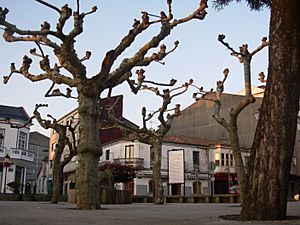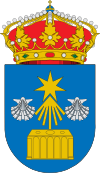Arzúa facts for kids
Quick facts for kids
Arzúa
|
||
|---|---|---|
|
municipality
|
||
 |
||
|
||

Location of Arzúa within Galicia
|
||
| Parroquias | Santa María de Arzúa, Santiago de Arzúa, Boente, Brandeso, Branzá, Burres, Calvos de Sobrecamiño, O Campo, Castañeda, Dodro, Dombodán, Figueiroa, Lema, Maroxo, A Mella, Oíns, Pantiñobre, Rendal, Tronceda, Viladavil, Vilantime & Viñós | |
| Area | ||
| • Total | 155.89 km2 (60.19 sq mi) | |
| Population
(2018)
|
||
| • Total | 6,053 | |
| • Density | 38.829/km2 (100.566/sq mi) | |
| Time zone | UTC+1 (CET) | |
| • Summer (DST) | UTC+2 (CEST) | |
| Website | Concello de Arzúa | |
Arzúa is a town, also known as a municipality, located in the A Coruña province. This province is part of Galicia, an autonomous community in northwestern Spain. An autonomous community is like a region with its own local government.
The area of Arzúa is about 155.89 square kilometers. In 2012, around 6,315 people lived there. This means about 40 people lived in each square kilometer. Arzúa is also known for having many cows compared to its population.
People have lived in this region for a very long time, even before the Romans arrived. Today, many people in Arzúa have ancestors from the Basque region.
Arzúa is an important stop for many pilgrims walking the Camino de Santiago. This famous journey ends in Santiago de Compostella. The French Way and the Northern Way of the Camino join together in Arzúa. This happens right before pilgrims reach their final destination in Santiago.
Who Lives in Arzúa? (Demographics)
Demographics is the study of how populations change over time. It looks at things like how many people live in a place and how that number changes. Here's how Arzúa's population has changed:
| Historical population | ||
|---|---|---|
| Year | Pop. | ±% |
| 1900 | 9,036 | — |
| 1930 | 8,743 | −3.2% |
| 1950 | 10,754 | +23.0% |
| 1981 | 7,377 | −31.4% |
| 2012 | 6,315 | −14.4% |
| Source: Article in Spanish and Galician | ||
As you can see, the population of Arzúa has changed quite a bit over the years. It grew until 1950 and has slowly decreased since then.
What to Eat in Arzúa? (Cuisine)
Arzúa is famous for its delicious cheese! The municipalities of Arzúa and A Ulloa are known for being the home of Arzúa-Ulloa cheese. This cheese has a special status called "Protected Designation of Origin" (PDO).
A PDO means that a food product must be made in a specific region. It also has to follow traditional methods. This ensures its quality and unique characteristics. So, when you try Arzúa-Ulloa cheese, you know it's truly from this special area.
See also
 In Spanish: Arzúa para niños
In Spanish: Arzúa para niños


